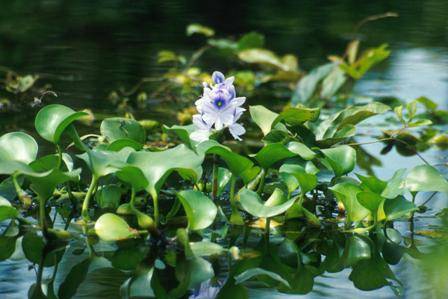
To overcome the danger of agrochemicals and pesticides for the growth of the crops, the agro scientists are working on the biofertilizers and has come out with a new idea using water hyacinth. Water hyacinth are available in plenty in the lakes, water ponds and such likw other water bodies.
Water hyacinth (Eichhornia crassipes) is a free floating freshwater plant of the family Pontederiaceae that has proven to be a significant economic and ecological burden to many sub-tropical and tropical regions of the world . Water hyacinth (Eichhornia crassipes) has been called the world's worst aquatic weed. It is a free floating water plant that is native to South America. It can vary in size from a few inches tall to over three feet. This plant has blue-green leaves.
It grows in mats up to 2 meters thick which can reduce light and oxygen, change water chemistry, affect flora and fauna and cause significant increase in water loss due to evapotranspiration.
Water hyacinth originated from the Amazon Basin and was introduced into many parts of the world as an ornamental garden pond plant due to its beauty. It has proliferated in many areas and can now be found in all continents apart from Europe.
Composting of weeds is suggested by Dr S. Porpavai, professor and head of Soil and Water Management Research Institute (SWMRI) at Thanjavur to overcome the problem of ‘water hyacinth’. She said that the institute has developed a method for ‘composting’ weeds such as ‘water hyacinth’ (Eichornia crassipes rpt Eichornia crassipes), ‘parthenium, cyperus (Cyperus rotundus)’ and ‘cynodon (Cynodon dactylon)’.
“We require 250 grams of Trichoderma viride and Pleurotus sajor-caju consortia and five kg of urea to prepare the compost. An elevated shaded place should be selected-area 500 cm x 150 cm and marked. The material to be composted should be cut to 10 to 15 cm in size. About 100 kg of cut material should be spread over the marked area. About 50 grams of microbial consortia should be sprinkled over this layer. About 100-kg of weeds are spread on this layer. One kilo gram of urea is sprinkled uniformly over this layer, This process is repeated until the level rises to one meter. Water is sprinkled as necessary to maintain a moisture level of 50 to 60 per cent. Thereafter, the surface of the heap is covered with a thin layer of soil. The pile is turned thoroughly on the 21st day. The compost is ready in about 40 days,” said Porpavai. “This can be used as a biofertilizer for all crops” Porpavai said.
- Subramanian, District Development Manager (DDM) of National Bank for Agriculture and Rural Development (NABARD) said that ‘water hyacinth’ can be made use as a source of income in rural areas. It is possible that the plant parts especially the stems could be used for making paper and handicrafts.
As ‘water hyacinth’ contains fibres, it can also be used in the textile industry for manufacturing clothing and home fabrics. The Self Help Groups (SHGs) in rural areas can take up this sort of activities, said Subramanian.
As the availability of water hyacinth is seasonal, the other fibre plants like banana can also be used for extraction of the fibres during the off-season. “NABARD is in the process of imparting training to the SHG members for making products from natural plant fibres such as jute, banana fibre and water hyacinth under its “Micro Enterprises Development Programme (MPED) during the current financial year in Thanjavur district,” he further added.















